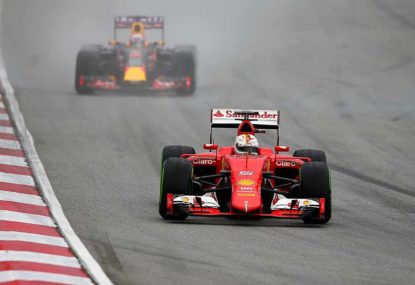Huge shake-up at Team Arrow McLaren for the rest of the IndyCar season: Pourchaire in, Malukas out
Theo Pourchaire replaces David Malukas, who got injured and then fired before he could even sit in the car.

Technically Ferrari don’t have to cook anything, given the Ristorante Cavallino has been feeding the Scuderia for years, but at the risk of adopting another foolhardy Carlton slogan, Mercedes know Ferrari are coming.
While Mercedes have had a considerable edge over their opposition for the last 16 months, up until the Canadian Grand Prix fuel consumption on the W06 Hybrid and (Mercedes-powered) Williams cars weren’t getting towards the peak of their fuel allowance.
They simply had too big a margin over the opposition and weren’t using all the power they had available.
In Canada, suspecting Ferrari was going to be more of a threat – by virtue of their recent engine upgrade – Mercedes found themselves much closer to the limit on fuel, and thus requested their drivers to drive through a narrowing goal-post to safeguard a victory.
Considering Ferrari gave away 50bhp to Mercedes last year, the race to catch the team at Brackley was always going to represent a moving target. That said, at the beginning of 2015 Ferrari managed to squeeze in an extra 65bhp compared to Mercedes’ meagre 20bhp.
If those figures are accurate then Maranello only require another 5bhp to be on equal footing with Mercedes.
All the same, Ferrari’s Montreal upgrade represented a net gain of an additional 15bhp – meaning they now led Mercedes in the horsepower stakes by 10bhp.
So why then were Kimi Raikkonen and Sebastian Vettel mired back in fourth and fifth respectively?
A slow-corner spin from Raikkonen on his out-lap (following his only pit stop), saw him lose 12 seconds and third place to Williams’s Valtteri Bottas. Raikkonen later cited a torque map as the reason for the spin.
“I don’t know how to explain but it’s on the edge,” said Raikkonen. “You move the pedal a little bit and you get a massive difference on the torque and there’s no way that I could have controlled it anymore.”
Engine-mapping issues have plagued Red Bull’s Renault power unit since the beginning of the year, only they’ve been wrestling a troublesome engine with a vastly inferior power range than Ferrari’s.
After experiencing a loss of engine power in qualifying, Vettel managed to make his way from 18th on the grid to fifth, implying any mapping issue was confined to Raikkonen’s car and thus easily repairable.
While Vettel’s engine issue has been kept under wraps, engine upgrades do require some cooling modifications. Generally there are five types of circuits around which teams have to plan their cooling requirements, all of which need to factor in engine oil, engine water, ERS oil (for the batteries), ERS water, hydraulics and gearbox and power-steering.
So far Ferrari technical director James Allison and his team have done by far the best job in maximising their cooling package and there’s no reason to expect they won’t find their way around the issue in double-quick time.
A complete scrapping of the engine token system might even allow other teams to solve their own problems and produce some better racing – but that’s another story.
The potential threat from Ferrari didn’t appear to rattle Nico Rosberg’s cage in Canada, the German claiming, “even though Ferrari are throwing everything at it, we seem to be able to keep our advantage.”
However it was Lewis Hamilton – statistically the faster of the two Mercedes drivers – who appeared more cautious.
“We didn’t get to see Ferrari’s true pace,” said the Briton. “I think at the next race we will.”
We’ll discover the substance behind Hamilton’s concerns in just over a week’s time in Austria.